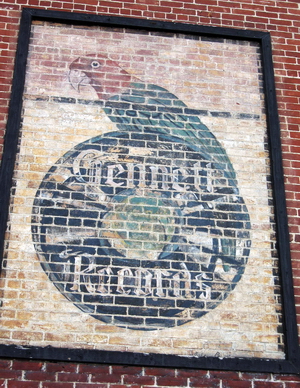|
Meeting Report:
Canada’s Audio-Visual Legacy is Fading Away
by Barry R. Ashpole
Canadians possess an exceptionally
valuable cultural heritage, and without
it there cannot be a complete under-
standing of who we are, where we have
come from, and the unique and common
experiences which created our individual
and shared identities. Film, video and
sound recordings are vital components
of our collective memory. They are the
animate testimonials of our achievements over the
past 100 years, documenting for all generations to come the
hopes, the successes and the differences
that have informed the views we hold of ourselves, of the
world and of our visions for the future.
Not Only in Canada. This dilapidated elevator shaft is what remains of
the building in Richmond, IN, that once housed The Starr Piano Company.

|
|
This vast source of information,
inspiration and creativity...is threatened.
Through technological obsolescence,
negligence and physical degradation of audio-visual materials, we are losing large parts of our recorded past. Jean Pierre
Wallot, National Archivist of Canada, June 1995.
Vital elements of Canada’s audio-visual legacy
are disappearing, deteriorating and becoming
increasingly inaccessible — and the rate
of these
alarming losses is accelerating.
Audio-visual
materials
— film, video and sound recordings
— are inherently
fragile, subject to rapid physical
degradation and technological
obsolescence.
Urgent intervention is required.
In 1994, the Minister of Canadian Heritage supported the creation
of the Task Force on the Preservation
and Enhanced Use of Canada’s Audio-Visual Heritage,
with a one-year mandate to identify and study the issues
and develop an action plan. In June 1995, after an
exhaustive cross-country consultation process involving
dozens of special and public interest groups, the Task
Force published its report, Fading Away: Strategic
Options to Ensure the Protection of and Access to Our
Audio-Visual Heritage. And in January of this year,
plans were made public to form a "consortium" of key
players charged with the responsibility of implementing
the recommendations contained in the report and
undertaking specific initiatives.
The work of the Task Force and the proposed
action plan was the focus of a presentation at CAPS
February meeting. The Society’s two visiting speakers
prefaced their talk with a video titled Fading Away. It
reminded those present of a number of sobering facts.
For example, of the twenty feature films produced in
Canada between 1913 and 1929 only one has survived.
Thousands of hours of television programming on
video tape have been erased. Only a handful of Canada’s
earliest recordings for radio broadcasts
— recorded on glass acetate discs during the 1920s and 1930s
— remain. And of the many thousands of early cylinder and disc
records made during the first quarter
of this century the only surviving copies are housed in a few sound
archives or in the hands of private collectors.
The well-weathered logo is of the Starr Piano Company's
famous Gennett studios, pioneers in recorded jazz.

|
|
Jeannette Kopak, Head of Program Information
for the English Network of the Canadian Broadcasting
Corporation (CBC), and Pat Kellogg, Manager of the
CBC Radio Archives, and the Corporation’s record
and music libraries, walked the sixty members present
through the Task Force's report, offered an overview of
the issues, and discussed "next steps". Jeannette talked
from the perspective of a member of one of the Task
Force's study groups; Pat from the point of view of
someone actively involved in a number of ongoing
sound preservation projects.
The issues to be resolved include: the selection
process and criteria to be used in deciding what film,
video and sound recordings to retain and preserve (and
what technology to use in the latter); the facilities and
technical expertise required for the physical preservation
of this material (including how to access now obsolete
playback and copying equipment); the storage of material
in environmentally safe and accessible facilities; a description of holdings and how interested parties can access
this information; the recognition and protection of both
intellectual property rights and commercial
interests; and, the required human and financial resources.
The responsibility for a successful action plan must
be shared, stressed Jeannette. Often the mandates of
interested parties can be at conflict. By way of an
example, she explained: "The CBC — the country’s
largest creator of audio-visual content — abdicated its
responsibility for preservation, allowing the National
Archives to step in and do the job for us. This has
caused a number of problems for both organizations.
The CBC sees its archives as its corporate assets, to be
exploited if possible, and the National Archives sees...
CBC's archives as a National, cultural treasure to be
preserved. The National Film Board and Ontario
Cinematheque have similar problems."
A national strategy to save Canada’s audio-visual
legacy will focus on the preservation of: audio visual
recordings (including unedited material) produced before
1940; Canadian films and sound recordings produced
before 1950; television and radio programs produced in
Canada before 1960; Canadian sound recordings produced
and published before 1970; Canadian video recordings
in non-standard formats produced independently
before 1980 and music videos from the same period.
Jeannette outlined some of the priorities: the need
to free up funds to finance the action plan; the establishment of common, regional storage facilities; the creation of a centre
of expertise for obsolete and deteriorated formats;
the integration of preservation and
conservation management into the production of new
audio-visual recordings; the research and development
of archival standards, and training and exchange pro-
grams to advance them.
Work to establish the proposed "consortium" has
begun. (For information you can contact: Marielle Cartier,
Chief of Audio-Visual and Reference Collections,
National Film Board, Montreal, PQ., at [514] 737-5994.)
"The intent," commented Jeannette, "is to throw
the responsibility for the consortium into the hands of
the private sector. Although the National Archives can
act as a facilitator and can help with setting it up, the
responsibility for the success of the venture lies with
those organizations who have a stake in Canada’s
audio-visual heritage."
|